Accepted Scientific Name: Raphionacme splendens subs. bingeri (A.Chev.) Venter
S. African J. Bot. 75: 337 2009.
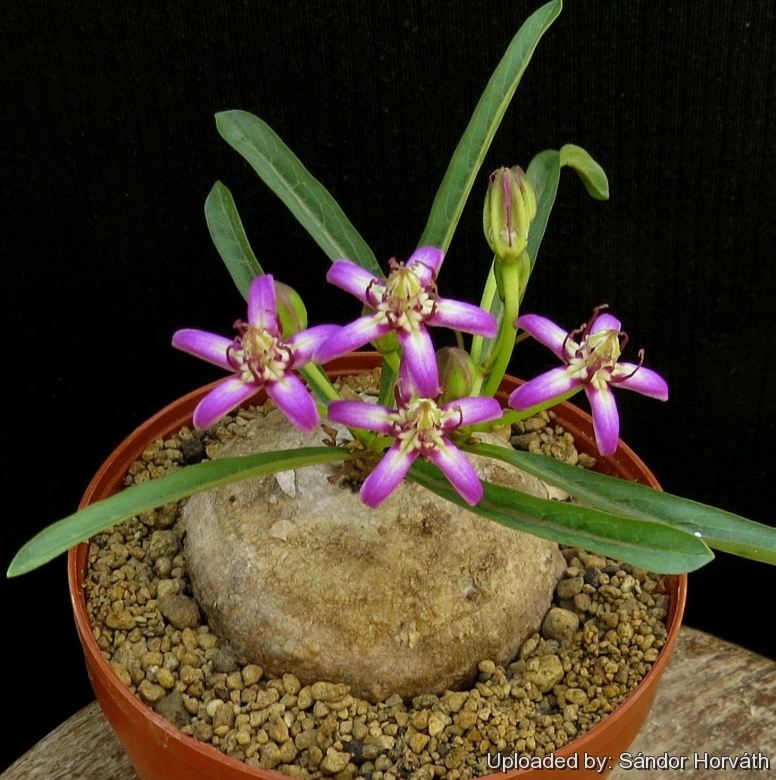
Brachystelma bingeri (Raphionacme splendens subs. bingeri) Photo by: Sándor Horváth
Origin and Habitat: Raphionacme splendensSN|31940]]SN|31940]] subs. bingeri is found from Senegal and Gambia east to southern Sudan and Uganda. Raphionacme splendensSN|31940]]SN|31940]] subsp. bingeri has a more western distribution, while R. splendens subsp. splendens were found to be distributed in eastern Africa.
Altutude range: From sea level to about 1500 metres.
Habitat and ecology: This species is found in clayey or sandy-clayey terrains often among rock, in shallow soil or sandy areas usually rich in humus. Occurring in grassland, scrub and open woodland, it is often observed growing in the shade of thick bushes and large trees, such as the Cordyla africana. Even though both Raphionacme splendensSN|31940]]SN|31940]] subspecies occur in the same type of vegetation, R. splendens subsp. bingeri is found in more humid habitats compared to
R. splendens subsp. splendens.
Synonyms:
See all synonyms of Raphionacme splendens
Common Names include:
BAMBARA (Bamanankan): fié, fié-gué, fié-hié, figué
FULA or FULANI (Fulfulde, Pulaar, Pularl): nda-fegué
JOLA or DIOLA: hiama
MANDINKA or MANDING ((Mandi\'nka kango لغة مندنكا): fikongo
Description: Raphionacme splendensSN|31947]]SN|31940]] subs. bingeri is a caudiciform asclepiad with zig-zag shaped herbaceous annual stems up to 20 cm tall, growing from a sub-spherical tuber, up to 25 cm in diameter. This subspecies species is remarkable for its very few broader leaves ranging from ovate to elliptic, and conspicuously smaller purple flowers. It is an exceptionally beautiful species. Raphionacme splendensSN|31945]]SN|31940]] subs. bingeri is a geographical form of Raphionacme splendensSN|31940]]SN|31940]] distributed on the western part of the range, but not sufficiently differentiated from the standard R. splendens to be considered a good species in its own. R. splendens is one of the most widespread and morphologically variable taxon of the genus. Many of its geographical variant was early classified as different independent species, but nowadays all this plant are considered part of a multiform species, where each form is linked to others by populations of plants with intermediate characteristics. Venter (2009) regards Raphionacme bingeriSN|31940]]SN|31945]] morphologically as sufficiently unique to be given subspecies status.
Derivation of specific name: “splendens” Lat., “splendid”, for the bright flower colour.
Root tuber: Flattened turnip-shaped, 5-5 cm tall, 2-25 cm wide with white flesh exuding latex when cut.
Annual stems: Erect, zigzag-shaped, 15 - 20 (-30) cm tall, 2 -3 mm in diameter, unbranched, terete, young minutely pubescent.
Leaves: Distant, the two or three lower pairs reduced to mere rudiments or scales, the upper ones erect, elliptic-elongate or obovate, about 5 cm long and up to 4 cm wide, almost glabrous or variably short-hairy.
Inflorescence: Terminal or subterminal lax cymes, extra-axillary, shortly pedunculate, few-flowered with 2-4 flowers. Pedicels 7-25 mm long, slightly pubescent.
Flowers: Sepals ovate, 2-3 mm long, 1.5-2 mm wide, acute, outside pubescent to hispid; Corolla campanulate 20-50 mm across. Corolla tube 1.5-5 mm long. Corolla-lobes, completely spreading, oblong, 10-25 mm long, 6 - 7 mm wide, obtuse, white, rose to purple adaxially, outside scattered weakly pubescent, inside glabrous. Corona lobes erect, filiform from a broadened base with 2-keeled inside, 5-25 mm long, far overtopping the gymnostegium, apically often incised and contorted. Stamens 5 mm long, conical attached at the inner apices of the conspicuous coronal feet. Anthers linear 6 mm long, linear, glabrous, connivent over the tapering angular apex of the style, and connate at their tips. Gymnostegium completely protruding from the corolla- tube. Translator spatulate, about 3.5 mm, with a deeply bifid lanceolate blade.
Fruits (follicles): Erect, linearly fusiform, 8-10 cm long 4-5 mm in diameter.
Phenology: The plants comes into vegetation in May and blooms in June-July.
Note: The West African "Raphionacme daroniiSN|31940]]SN|31947]]" is a smaller-flowered variant of this extremely widespread complex characterized by the long-stipitate stylar head, which surpasses the corolla considerably.
Subspecies, varieties, forms and cultivars of plants belonging to the Raphionacme splendens group
Raphionacme splendens Schltr. is the most widespread species of Raphionacme and comprises two subspecies: subsp. splendens and subsp. bingeri (A.Chev.) Venter.
- Raphionacme splendens Schltr.: (subsp. splendens) has erect herbaceous annual stems to 50 cm tall, distinctly thinner leaves ranging from linear to lanceolate and flowers that are conspicuously larger. Distribution: Chad, Ethiopia and Sudan south to Angola, Cameroon, Burundi, Rwanda, Sudan, Uganda, Kenya, Tanzania, Malawi, Mozambique, Zambia and Zimbabwe.
 Raphionacme splendens subs. bingeri (A.Chev.) Venter: has zigzag-shaped stems, distinctly broader leaves ranging from ovate to elliptic and flowers that are conspicuously smaller. Distribution: Senegal and Gambia east to southern Sudan and Uganda.
Raphionacme splendens subs. bingeri (A.Chev.) Venter: has zigzag-shaped stems, distinctly broader leaves ranging from ovate to elliptic and flowers that are conspicuously smaller. Distribution: Senegal and Gambia east to southern Sudan and Uganda.
Bibliography: Major references and further lectures
1) Urs Eggli "Illustrated Handbook of Succulent Plants: Dicotyledons" Springer Science & Business Media, 2002
2) Werner Rauh "The Wonderful World of Succulents: Cultivation and Description of Selected Succulent Plants Other Than Cacti" Smithsonian Institution Press, 1984
3)James Cullen, Sabina G. Knees, H. Suzanne Cubey "The European Garden Flora Flowering Plants: A Manual for the Identification of Plants Cultivated in Europe, Both Out-of-Doors and Under Glass" Cambridge University Press, 11/Aug/2011
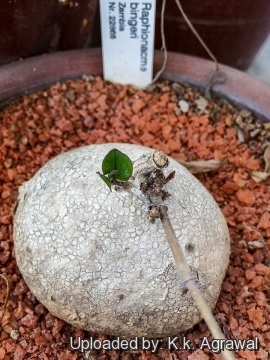 - After a long dormancy... (Raphionacme splendens subs. bingeri) Photo by: K.k. Agrawal
- After a long dormancy... (Raphionacme splendens subs. bingeri) Photo by: K.k. Agrawal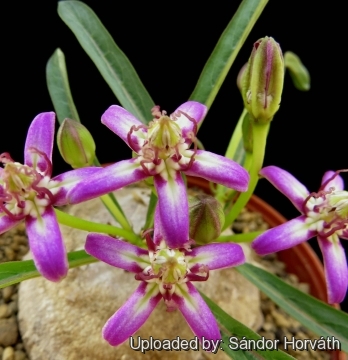 Brachystelma bingeri (Raphionacme splendens subs. bingeri) Photo by: Sándor Horváth
Brachystelma bingeri (Raphionacme splendens subs. bingeri) Photo by: Sándor Horváth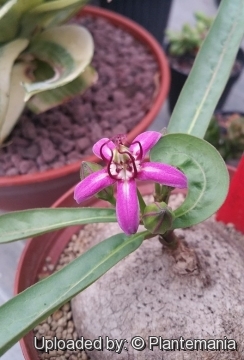 Brachystelma bingeri (Raphionacme splendens subs. bingeri) Photo by: © Plantemania
Brachystelma bingeri (Raphionacme splendens subs. bingeri) Photo by: © Plantemania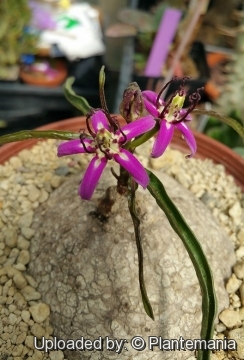 Brachystelma bingeri (Raphionacme splendens subs. bingeri) Photo by: © Plantemania
Brachystelma bingeri (Raphionacme splendens subs. bingeri) Photo by: © PlantemaniaCultivation and Propagation: In cultivation the plants are usually grown in semi shade, with the tubers wholly or (preferably) partially exposed to prevent scorching and rotting of the roots. This plant can take a good deal of water during active growth and should be watered only when not dormant. Keep dryish in winter. It should be overwintered in the greenhouse at temperatures over 12°C (avoid letting temperatures drop lower than 5° C). Use a very draining but rich soil. An error in cultivation may produce unsightly holes in the tuber.
Food uses: This species has a large edible tuber. The flesh consists largely of carbohydrate matter, and is refreshing rather than nutritious. The tuber exuding latex when cut tastes slightly bitter, and is eaten fresh (raw) or boiled, after having removed the milky and resinous peel. Europeans have used it boiled in water as a substitute for turnips. In West Africa the tuber and fruits are mainly eaten as a famine food. The tuber of this species has been occasionally confounded with the similar tuber of Euphorbia bagaSN|31948]]SN|31948]] which is very toxic.
Medical uses: A leaf decoction is used as eye drops to treat conjunctivitis. In Congo the sap from the tuber is applied to scarification of the temples to treat headache.
Reproduction: This species can be reproduced by seeds.














